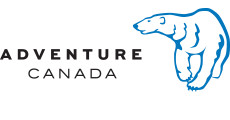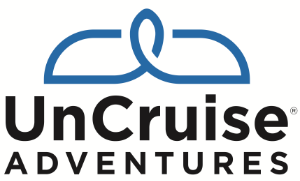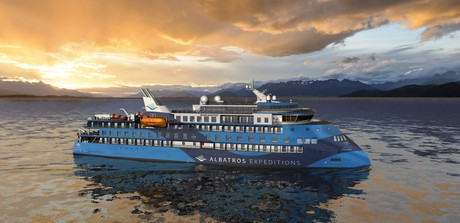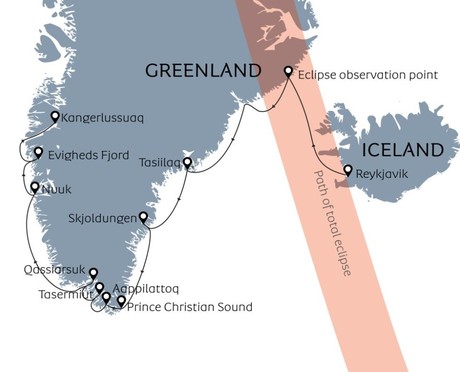Greenland Solar Eclipse Expedition Cruise 2026
Experience one of nature's most dazzling phenomena in one of the world's most awe-inspiring destinations. Experience totality in wild East Greenland. Experience with us.
On August 12, 2026, a total solar eclipse will pass southwards through mountainous Northeast Greenland. At 16:37 in the afternoon, the shadow of the moon will reach the dramatic and isolated Blosseville Coast in East Greenland. Our vessel Ocean Albatros will be anchored close to shore at the exact centre of the total eclipse. Sheltered from the ocean, our calm landing beach will provide unobstructed view towards the western sky. Totality will last for 2 minutes and 17 seconds.
This unique solar eclipse, far away from any inhabited location, is a fitting start to our grand expedition cruise from East to West Greenland. Departing the hip Icelandic capital of Reykjavík, we will sail directly for the eclipse area to witness this natural wonder, surrounded by staggering natural beauty. Following this spectacle, we will cruise southward along the east coast of Greenland, witnessing glaciers flowing from the snow-capped peaks of the Watkins Mountains, experiencing unique East Greenlandic culture in the town of Tasiilaq, and marvelling at the stunning fjords and glaciers of Skjoldungen. From here we will sail through the magnificent strait of Prins Christiansund, a glacier-lined channel separating Kap Farvel (Greenland's southernmost point) from the mainland. We will next venture deep into the fjords of South Greenland to visit the ancient remains of Erik the Red's farmstead. The lush green pastures and rolling hills of South Greenland make it easy to see why the Norse settlers gave the island the name it bears to this day - and why the Norse chose to settle in this green paradise.
Following the magnificent coastline of Earth's largest island, we will visit Nuuk, one of the smallest world capitals. Nuuk still has a strong Greenlandic vibe; tiny traditional wooden houses sit in the shadow of glassy towers, and locals buy seal and whale meat at the city market. From Nuuk we will chart a course for Evighedsfjord, the“Fjord of Eternity”, where several glaciers flow from jagged peaks down into the plunging depths of the fjord. After twelve days on this exciting and unforgettable eclipse cruise, we disembark in Kangerlussuaq, ready for the flight back home. Our expedition vessel Ocean Albatros is a revolutionary and stylish small ship that combines exquisite comfort with modern technology as well as unique stability in rough seas. First-class dining and expert lectures on astronomy, zoology, geology, and Inuit culture will enhance this unique voyage to witness totality on Earth's largest island.
The rock-like columns of Hallgrímskirkja Church loom over the city of Reykjavik, a hip Scandinavian capital which needs little introduction. With new Nordic cuisine, excellent shopping, fantastic excursions and an easy relaxed vibe, Reykjavik is one of Scandinavia's most welcoming and exciting cities. Explore the city's world class (and often very quirky) museums, shop for snuggly local sweaters, or simply watch this bustling city in action on a cozy cafe terrace.
MV Ocean Albatros awaits embarkation in the city's bustling harbour, with comfortable staterooms ready to welcome our guests. After our mandatory safety briefings and lifeboat drill, Ocean Albatros will sail out of Reykjavík and chart a course for the wild east coast of Greenland.
The Denmark Strait is the narrow section of the North Atlantic Ocean separating Iceland from Greenland. This body of water is among the most productive in the world, where the cold polar East Greenland Current collides with the warm northbound Gulf Stream. These nutrient-rich waters support vast stocks of fish, and in turn the humans, seals, whales and seabirds which rely on them. As Ocean Albatros sails across the Denmark Strait, our eclipse experts onboard will take careful note of weather and ice conditions at the eclipse location and instruct our guests on procedures to safely view and photograph the eclipse. As we approach Greenland, our onboard team will also provide information on the ecology, geology and wildlife of the area, as well as ensuring our guests are informed on important topics such as Zodiac operations and polar bear safety. In other words, getting prepared for the adventure to come!
During the early hours of the day, we approach the massive rock walls of the Blosseville Coast. A hundred years ago this coastline was feared by sailors due to the almost permanent sea ice, which even in summer could trap and crush unsuspecting ships. However, warmer temperatures during the last decades and huge advances in marine technology mean this forbidding coast and its sheltered landings in the dramatic fjords can now be accessed by certain ice-strengthened vessels such as ours.
For this important day, Albatros Expeditions have carefully researched the best possible viewing location – a location as close to eclipse centre line as possible, with easy Zodiac access, views unobstructed by mountains to the southwest and likely to have clear skies. Ocean Albatros will drop anchor close to the shore around noon. Our expedition staff will scout the area for wildlife, and after lunch all guests will get ashore by Zodiac in good time to set up their equipment and view this natural wonder.
The shadow of the moon moves toward us from north Greenland at a speed of 4,000 kilometre per hour. The partial eclipse begins at 16:37 local time (the same as UTC and Reykjavík time), and the totality begins at 17:37. The sun at maximum eclipse will be in the southwestern sky, unobstructed by any mountains at the mouth of our little fjord. At 17:40 the first rays slip past the lunar disk to create the legendary “Diamond Ring” – and then the totality is over. The spectacle ends around 18:33 when the last fringe of the moon leaves the solar disk, and the shadow continues south toward the northern coast of Spain. We will pack up our equipment, tripods, and other belongings and return to the ship, where a gala dinner has been prepared for this very special day!
Eclipse photography - a word of advice
Much has been written about how to take good pictures during a solar eclipse. The most important phrase in almost all these descriptions is: DON’T! It is extremely difficult to get good pictures, especially during totality, and it requires very advanced equipment and knowledge. If you do not have this, you risk missing the most important thing, namely experiencing the special and unreal atmosphere that a total solar eclipse gives. Instead, use the short span of the eclipse to observe the effect of the fast-changing light on the landscape. And when turning your eyes towards the sun, always wear the solar eclipse glasses provided to you by Albatros Expeditions.
Captain and his officers will steer Ocean Albatros south along Blosseville, the most dramatic coast outside of Antarctica. The tall and dark rock walls have their origin in the opening of the Atlantic Ocean, when Norway and Greenland separated, and thousands of cubic kilometres of lava flowed up through Earth’s crust. The dramatic layers of black rock bear testament to countless volcanic eruptions in the region approximately 50 million years ago. A magnet for geologists from around the world, this fascinating region was first surveyed by legendary Danish explorer Ejnar Mikkelsen.
If ice and weather conditions allow, the Expedition Leader and Captain will try to arrange for a shore landing at the mouth of Kangerlussuaq, a typically descriptive Greenlandic name meaning “Big Fjord”. Despite the forbidding landscape and the brutal weather of the region, ancestors of today’s Inuit have lived in the region for thousands of years. A few abandoned Inuit settlements and expedition huts are scattered in this otherwise untouched and otherworldly landscape.
Proceeding along the coast, we soon arrive at Tasiilaq, the largest settlement in East Greenland. Unlike the west coast, which has had uninterrupted contact with Europe since the 1700s, the coast of East Greenland remained more or less uncontacted until around 1894, when a Danish trading post was established at Tasiilaq by Gustav Holm’s famous Skin Boat Expedition. The vast distances involved in Arctic travel meant that the people of East Greenland (Tunumiit) were isolated from their cousins to the west, and the language, traditions and culture of East Greenland therefore differ significantly to those in other parts of the country.
Ancient traditions are strong here. This region of Greenland was the home of the last Angakkuit (Shamans) of Greenland, and is the home of the tupilak - a monster fashioned from animal (and sometimes human) body parts and animated by the power of an Angakkuq to wreak havoc on enemies. Creating such a monster was dangerous, as it could be turned back by a more powerful magic user to attack its creator. The first Europeans were curious as to what these dark beasts looked like, and locals carved facsimiles in bone or horn, beginning one of Greenland's finest artistic traditions. The tupilaat made by artisans in Tasiilaq are considered among the best in the country.
Tasiilaq sits in a perfect natural harbour on Ammassalik Island (meaning 'the Place of Many Capelin'). While superficially similar to towns on the West Coast, the landscape here is much more rugged, the people fewer, and the sled dogs much more numerous. Tasiilaq offers excellent opportunities to explore, with excellent hiking routes such as the Flower Valley easily accessible from town. For those wishing to delve into Tunumiit culture, visit the museum, located in the city's old church, hear the city's exquisite choir perform in the modern church, or watch a drum dancer in traditional East Greenlandic costume perform a millennia-old spiritual tradition. For those wishing to indulge in some retail therapy, visit the Stunk Artist's Workshop, where skilled craftsmen create beautiful pieces from natural local materials.
Today's adventure begins as we sail into magnificent Skjoldungen, a staggeringly beautiful fjord on the southeastern coast of Greenland. The fjord is named for Skjold, an ancient Danish King of Norse legend, while the Greenlandic name, Saqqisikuik, references the sunny climate of the area. Various archaeological finds on the island which sits in the middle of the fjord suggests nomadic Inuit groups visited and stayed in the area in years gone by; more recently, settlers were brought from Tasiilaq to settle the island in the 1930s, but returned there thirty years later; some houses can still be seen on the southern side of the fjord. A small weather station was also operated on the island by the Allies during WWII.
Today uninhabited, Skjoldungen sits almost 300km from the nearest village, with Mother Nature its only ruler. Vast saw-toothed mountains lined with opalescent glaciers line the deep chilly waters of the fjord, which can freeze even in summer. At the head of the fjord lies the magnificent Thryms Glacier, a magnificent river of ice flowing down from the ice sheet. On the southern side of Thryms Glacier lies the sweeping U-shaped glacial valley of Dronning Maries Dal - a textbook example of a glacially-produced landscape. Join your expedition team for a walk on the flower-lined floor of this valley, and marvel at the stunning scenery. Ensure you are on the outer decks on our approach and departure from this magnificent fjord too: you will not be disappointed!
South of Skjoldungen lies Cape Farewell, which is renowned not only as Greenland's southernmost point, but also for its infamously challenging weather. With this in mind, we deliberately opt for a far more comfortable but also more spectacular route, cruising across to West Greenland via the inside passage of Prins Christian Sund. Known in Greenlandic by its typically descriptive name of Ikerasassuaq ('the Big Strait'), this 60 km long waterway reaches from the east coast to the settlement of Aappilattoq in West Greenland.
Prins Christian Sund is one of the most spectacular waterways anywhere on Earth. Kept free of ice year round by strong tidal currents, the strait is hemmed in on either side by mountains which rise straight out of the water some reaching over 2,000m in height. Large glaciers flow from the ice sheet into the sea on the northern side of the strait, while sapphire blue mountain glaciers loom over the water from the southern side, and vast icebergs stud the glassy waters.
By mid-afternoon we will visit the small village of Aappilattoq, which sits hunkered beneath the towering mountains at the end of Prins Christians Sund. The village is a world away from busy towns of West Greenland; life here moves at a slower pace, following the rhythms of the wind, waves and tides. Aappilattoq (meaning 'Red' in Greenlandic, referring to the stark granite bluffs above) offers excellent hiking opportunities, and the local choir is renowned throughout Greenland.
Tasermiut (meaning 'the Settlement by the Lake') is one of Greenland's best kept secrets. Extending northeastwards 75 km from the town of Nanortalik to the Ice Sheet, the fjord is lined by green, fertile side valleys and sheer granite walls reaching 2000 m above sea level. These rock walls are often compared to El Chalten in Argentina, or California's Yosemite, but in reality the sheer scale of these cliffs far exceeds both, and they are a lifetime goal for the world's most expert rock climbers. The Norse settlers called this waterway Ketil’s Fjord and build an Augustinian monastery in what is still called Klosterdalen (“Monastery Valley”). We will make a zodiac landing and a short easy hike to experience the fantastic landscape at the head of fjord - no climbing gear required!
Following the coast north, we reach the small island of Uunartoq, famous for its geothermal springs with year-round temperatures of 34-36 degrees centigrade. While the hot springs of Iceland are more famous, Uunartoq surely beats them all for sheer natural beauty; nowhere else in the world can you relax in perfectly hot water while icebergs float past in the sea nearby. In fact, many visitors use the frigid sea as the ideal cold plunge to enhance this natural spa! The Norse settlers knew this place as well, and remnants of a nunnery have been excavated on the island. We will make a landing on the island by Zodiac in the early evening and take turns to dip into the hot pool.
During the early morning we will cruise below the majestic mountains of Tunulliarfik Fjord towards the small village of Qassiarsuk. The fjords here are lined with lush green meadows and dotted with small sheep-farming settlements, of which Qassiarsuk is perhaps the best known.
While the modern village of Qassiarsuk was founded in 1924, the location has a fascinated and much longer history; it was here a thousand years ago that legendary Norse explorer, Eric the Red, settled after being banished from Iceland. Erik and his family set up a small farmstead in typical Norse style, naming new settlement Brattahlíð, “The Steep slope”. Erik himself kept fiercely to the Norse gods, but his wife Thjodhild was a Christian. Legend has it, she refused to join his bed until he built her a church, which he eventually did, constructing a tiny hut (Þjóðhildarkirkja) which was nevertheless the first church in the Americas.
Across the fjord lies Itilleq, a small bay where a trail leads to the village of Igaliku. During the afternoon, we will trek through the lush green hills to see the remains of the Norse Bishop's palace at Garðar - once a place of great power and influence in this remote corner of the Norse world.
From South Greenland, we will follow the rugged coast of this vast island northwards. All settlements in Greenland (with the exception of Kangerlussuaq) are situated directly on the ocean coast of the country, and the vast majority of residents (some 50,000 or so) live on the narrow strip of coast on the west of the country, facing the Davis Strait.
Ocean currents bring warm water up from the Atlantic to the west coast, enriching these wildlife-filled waters. During our day at sea, keep your eyes on the sea! Whales, seals and a huge variety of seabirds are common in these rich waters.
A mixture of skyscrapers and traditional wooden houses, the quaint and the cosmopolitan, Nuuk is a city of contrasts. The vibrant bustling capital of Greenland, Nuuk feels much larger than its 19,000 inhabitants, and offers a wealth of experiences to visitors. The calm fjords around Nuuk have been inhabited by Paleo-Inuit cultures since at least 2200 B.C., and archaeological evidence indicates waves of migration through the area as ancient hunters followed migrating prey. Around the year 1000 A.D., Norse colonist from Iceland established the Western Settlement in the green meadows of Nuuk Fjord; these settlers mysteriously disappeared several hundred years later leaving the island to the Inuit, who were far better equipped to live in Greenland's harsh environment.
Nuuk offers a huge amount to the discerning visitor; larger than any other city in Greenland, Nuuk has a bustling cosmopolitan vibe and hosts some of Greenland's best attractions. Swing by Kolonihavn district to visit the Greenlandic National Museum, a treasure trove of history stretching back to the first inhabitants of this icy island - including artefacts from the Paleo-Inuit and Norse periods, as well as the spellbinding Qilakistoq mummies. Explore Greenlandic culture at Katuaq, the city's cultural centre, and an architectural marvel; shop for authentic Greenlandic artworks in the city's many boutique shops, or simply relax at a hip curbside café with a Greenlandic coffee and watch this vibrant city in action. Nuuk York (as proud locals call it) is unlike any other city in Greenland, or indeed the world.
On the last full day of our expedition, we will arrive at the small village of Kangaamiut, an incredibly picturesque settlement in Greenland’s central Qeqqata region. Surrounded by cold rich waters and a vast back country brimming with game, life in Kangaamiut moves at a slower pace, and locals still live a largely traditional lifestyle, surviving by hunting and fishing. Hike to the heliport atop the hill for stunning views over the town and the surrounding fjordlands, or meet the friendly local people during a display of traditional clothing, foods, and seal-flensing. The artists of Kangaamiut are well-known throughout Greenland, and some of the locals' most splendid work can be viewed in the town's small museum.
In the afternoon, we will sail inland into Evighedsfjorden/Kangerlussuatsiaq, one of the many deep fjords carved between the steep mountains of this region. The Danish name 'Evighedsfjorden' means 'The Eternity Fjord', referring to the vast size of the inlet, while the Greenlandic name 'Kangerlussuatsiaq' translates as 'The Rather Large Fjord' - something of an understatement! Evighedsfjorden stretches around 100km into the glacier-clad mountains, bisecting the large ice cap which overlies much of the land between Nuuk and Sisimiut - Greenland's two largest cities. We will aim to explore on a Zodiac cruise in front of the Evigheds Glacier, which flows into the fjord from the Maniitsoq Ice Cap above. Watch for calvings from the glacier, and guillemots and kittiwakes on the nearby bird cliffs.
During the night, we will sail up the 160-kilometer/100 mile Kangerlussuaq Fjord. After breakfast aboard the ship, we will bid a fond farewell to the ship's crew, Expedition Team, and fellow travellers before shuttling ashore by Zodiac.
Due to Kangerlussuaq’s military history and present-day role as an important air travel hub, the town remains fairly isolated from Greenland’s rich cultural traditions in comparison to other regions. While you still find cultural experiences when visiting Kangerlussuaq, the most impressive attraction is the surrounding nature, which is just beckoning to be explored. Kangerlussuaq itself was largely constructed by the American military in the 1950s, and this small airport town has retained something of its Cold War atmosphere. Your Arctic adventure and time in Greenland concludes as we arrive at the sleek modern airport terminal – all of us with memories to last a lifetime.
Itineraries are subject to change.
|
Book now |
Category F Stateroom - Triple Stateroom (Porthole)

Category D Stateroom - Albatros Stateroom (Porthole)

Category E Stateroom - French Balcony Stateroom

Category C Stateroom - Balcony Stateroom

Category G Stateroom - Single Stateroom (Porthole)

Category B Suite - Balcony Suite
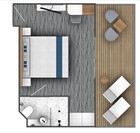
Category A Suite - Junior Suite
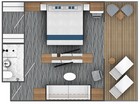
Premium Suite - Freydis Suite
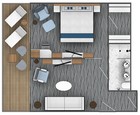
Family Suite - Brynhilde Suite

Vessel Type: Luxury Expedition
Passenger Capacity: 169 (95 cabins)
Length: 104.4 m
Built: 2022
The Ocean Albatros, sistership to the Ocean Victory, will join the fleet of Albatros Expeditions in November 2022.
The Ocean Albatros will be deployed to a large selection of expedition cruise destinations, Antarctica, the Arctic, any various exciting new destinations in between.
With a total of 95 comfortable staterooms and suites, all with unobstructed sea view, most with their own balcony, the Ocean Albatros will definitely become one of the most popular expedition cruise vessels in the world. Like it's sistership the Ocean Victory it offers two restaurants, a wellness area, an Albatros Nordic Bar, an open deck dining facility, a modern lecture lounge, and other state-of-the-art amenities. The vessel will have more than a 50% lower carbon footprint than traditional expedition vessels and be one of the most environmentally friendly, implementing the Green Initiative Program, ensuring both absolute comfort and sustainability for our guests. Unlike the Ocean Victory, the Ocean Albatros will also offer a unique panorama sauna, and a total of 12 dedicated solo travel cabins without a single-supplement.
BRIDGE
Due to its important role as a control center for all nautical and technical processes, the ship's bridge is a vital, sensitive place. Therefore, the bridge may not be accessible to the public at all times. Conditions permitting, we will be happy to welcome you into the bridge for a visit. Guests must be accompanied by the master or our expedition leader.
STATEROOM SERVICE
Your stateroom is serviced daily. We provide a turn-down service. We provide meal to room only for serious cases of guest being sick. Our suites will have VIP services.
ZODIAC LANDINGS
One feature of our expedition cruises includes landings and excursions aboard Ocean Albatros's fleet of 18 inflatable, motorized rubber "Zodiac" boats. The Zodiac brand has earned a well-deserved reputation as the sturdiest and safest small watercraft available. These boats have a low draft and great stability. Zodiacs are constructed for professional use and are outfitted with a top-quality outboard engine, yet their design minimally impacts the environment.
The Zodiacs are designed to provide unrestricted access to the world’s last great frontier. Their versatility enables us to make landfall on remote shores, cruise along awe-inspiring coastlines and share breathtakingly close encounters with whales, seals, penguins, seabirds and more. We will come within arm’s reach of icebergs and set foot on land discovered by pioneering explorers just over a century ago.
Your safety and comfort are our #1 priority, and your expedition leader will carefully plan for as many Zodiac excursions as possible, dependent upon the local weather and prevailing conditions. In each case, the expedition leader makes the final decision if the landing is possible or not. Safety regulations apply on landings. All guests receive a mandatory instruction of the safety guidelines. Life jackets are mandatory to wear.
Please note, we highly recommend the use of waterproof bags in order to protect your personal camera or binoculars, as both hands must be free of everything during boarding. Participation is fairly easy and comfortable for able-bodied guests but can be more challenging for those with physical handicaps.
GRATUITIES
Following international standards in the service industry, it is customary to leave gratuity for the ship’s crew at the end of the voyage. All gratuities will be divided among the crew. Typically, a recommended amount is approximately 13.5 USD per person per day. Gratuity is, of course, not required and any gratuity payments are voluntary.
DRESS CODE
The dress code on board is casual. Ties, jackets and evening dresses you may leave at home. It is rather more important to wear the right clothes in order to adapt to the different weather conditions. We recommend comfortable, breathable, waterproof and windproof clothing. Also, you should have a pair of gloves, thermal underwear and sturdy footwear in your luggage. For the captains and farewell cocktail, we recommend a smart casual dress style.
INTERNET / PHONE
Keep in mind, we will be cruising in a very remote region of the world. Where accessible, internet access is available for an extra charge. Mobile phone reception may be possible in select regions along our route. For further details please contact your mobile phone operator. Prices can be found in the information folder in your state room. Please ensure that your ‘Data Roaming’ function is switched off.
RECEPTION
The daily office hours of the board reception are from 06:00 until 23:00.
ALBATROS OCEAN SHOP
The selection of items available for purchase varies by ship, and may include a range of warm and practical clothing, as well as souvenirs, local arts and postcards at reasonable prices. A small selection of soap, toothpaste and other personal effects are also sold.
HEALTH / MEDICAL EMERGENCY
Each of our vessels has a small medical facility equipped with the necessary equipment and medicine to handle small emergencies. The infirmary is always staffed by a professionally licensed, English-speaking physician and nurse. Should a serious incident occur, the nearest hospital will be contacted. All guests must have personal travel/health insurance.
Although we do not have an official requirement regarding personal fitness, you should be able to move on board and ashore without the help of others. Please be aware that the ship does not provide wheelchair accessible state rooms.
Due to safety reasons a cruise is only possible for pregnant women until the 24th week of pregnancy. The state of pregnancy must be presented by a medical certificate.
PHYSICAL DISABILITIES / WHEELCHAIR ACCESSIBILITY
Guests with physical disabilities are recommended to travel with an accompanying person. The processes on board should be handled without external help. The gangway can be – depending on the individual disability – a challenge. The angle of inclination of the gangway varies due to tide and different circumstances in the respective port. Please note that the guest’s participation in shore excursions as well as the (dis-)embarkation by Zodiac can be denied by the expedition leader due to security reasons. The instructions of the expedition leader must be followed. The ship is not suitable for wheelchairs.
SEASICKNESS / STABILISATORS
The ship is equipped with stabilizers in order to reduce the ship’s roll. However, these expeditions are hosted in remote regions, and it is possible to periodically encounter changing environments and climate patterns, including rough seas and large swells. Seasickness patches (Scopoderm or similar) work solely or in part to help cure nausea for most people. These medicines can cause sleepiness. If you are prone to motion sickness, consult with your doctor prior to departure to help ensure your comfort while travelling.
SPECIAL DIETARY REQUESTS
All meals on board the vessel is chef-prepared. If you have special dietary requirements (food allergies, intolerances, health conditions or religious preferences), please inform us as early as possible - ideally, no later than 2 weeks before departure. In order to ensure efficient service, please re-confirm your requirements with the crew upon boarding the ship.
LAUNDRY
If you wish to have some laundry done while aboard the ship, laundry service is available for an additional fee.












Kayaking (345.00 USD)
Inclusions
• Voyage in selected cabin category
• Accommodation in shared inside or outside cabins as booked
• English speaking expedition team
• Shore landings by zodiac
• Information briefings and lectures held on board by expedition team
• All meals while on board
• Welcome and farewell cocktails
• Free tea and coffee on board
• Complimentary use of boots for shore landings
• Digital journal link after voyage (Includes voyage log, gallery, species list and more)
• Port Fees, taxes and AECO fees and tariffs
Exclusions
• Flights to/from departure port unless specified in itinerary
• Hotel accommodations unless specified in itinerary
• Travel Insurance
• Cancellation insurance
• Additional excursions and activities not mentioned in itinerary
• Meals when not on board the ship
• Beverages other than tea/coffee and water
• Gratuities for crew (recommended USD$14.00 per passenger per day)
• Any items of a personal nature
Highlights
• Total Solar Eclipse in East Greenland: Experience a mesmerizing total solar eclipse on August 12, 2026, from the Blosseville Coast aboard the Ocean Albatros, lasting 2 minutes and 17 seconds.• East Greenland Expedition Cruise: Sail from Reykjavík to South Greenland, exploring glaciers, East Greenlandic culture, and historic sites like Erik the Red's farmstead in just 12 days.
• Luxury on Ocean Albatros: Enjoy the comfort of the revolutionary Ocean Albatros, featuring first-class dining, expert lectures, and stability in rough seas for an unforgettable journey.
Our Associates Include
